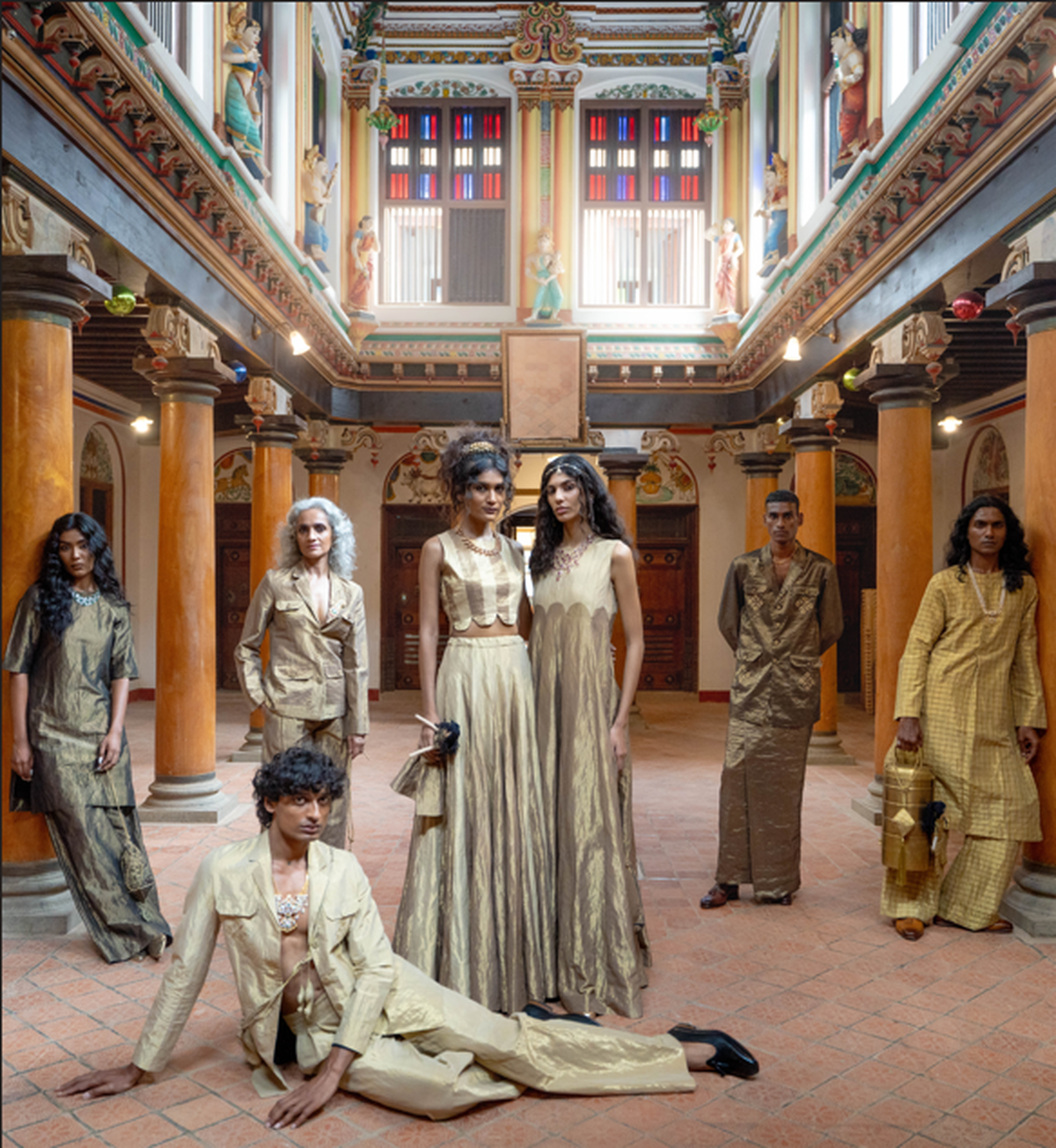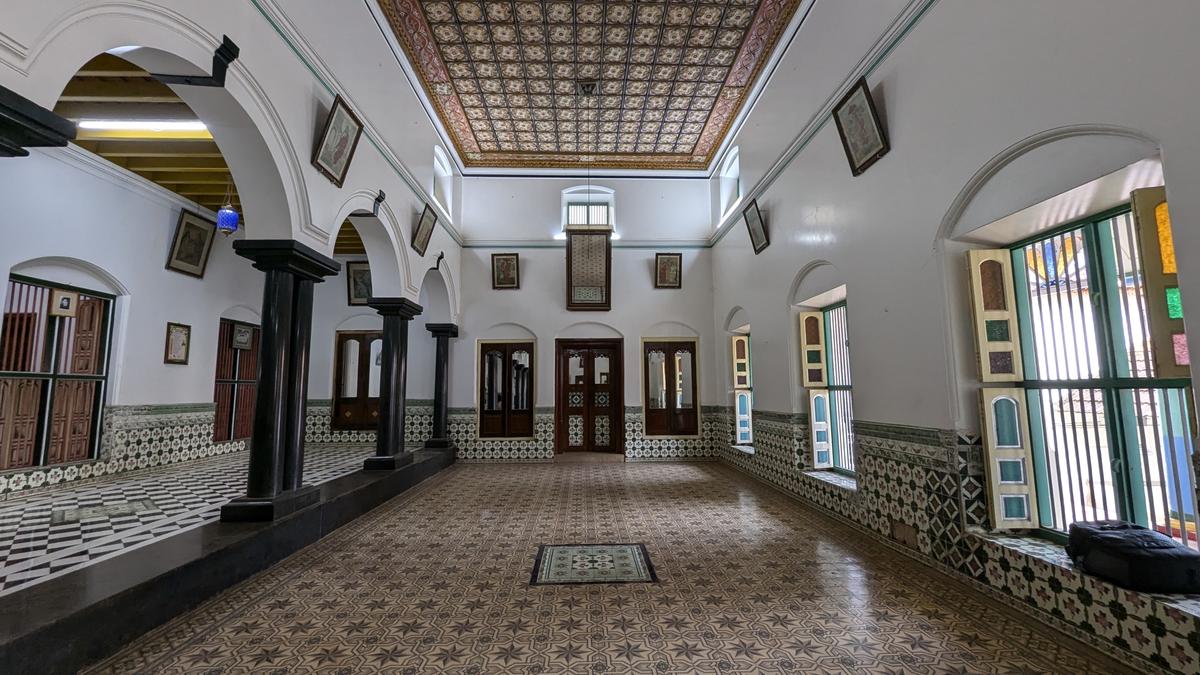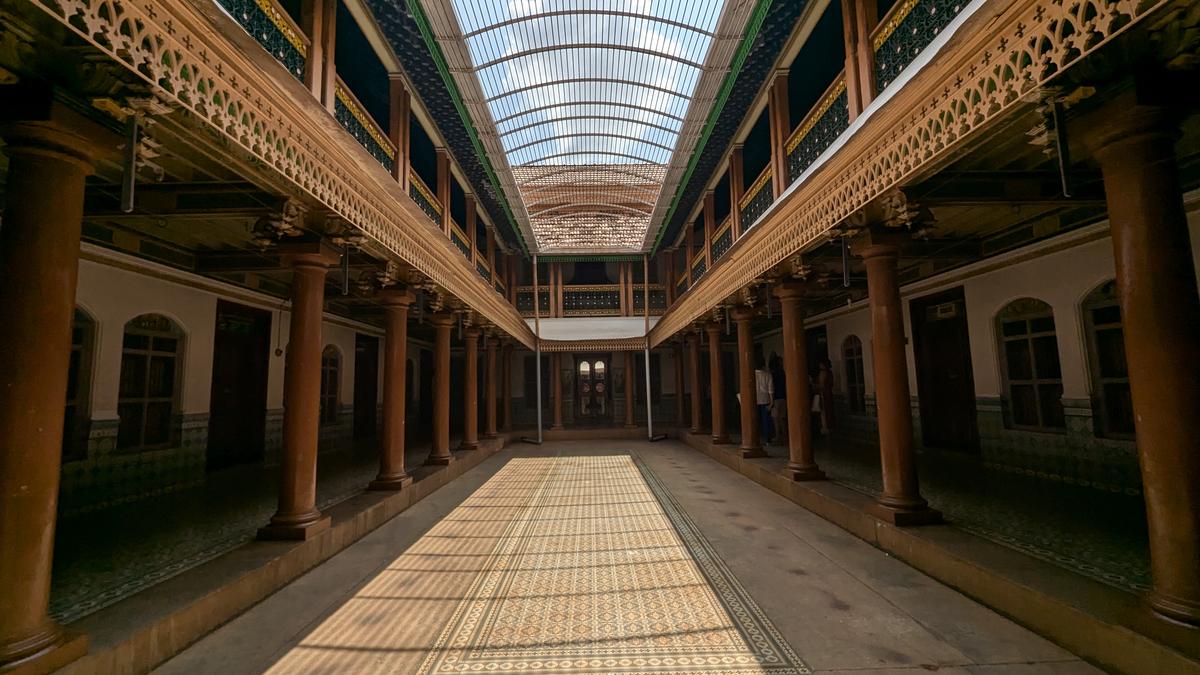[ad_1]
At the centre of the turbulent Karaikudi market, coloured by daily life, is an unexpectedly quiet oasis: a functional home, aged 108, where nine generations have lived and laughed, shared and fought, celebrated and cried. Lovingly referred to as periya veedu by the family, parts of the dining courtyard of this Chettiar mansion is now a jewellery store. Yet, a peek through the ornate doorway reveals a grand courtyard showing signs of daily life: perhaps a clothesline, or the odd silverware of steaming hot sundal.
A Chockalingam, the reticent seventh-generation part-owner, welcomes this writer in with an elaborate tour — he speaks of his moneylender grandfather who migrated to West Bengal from Burma, the 13 functional kitchens meant for as many daughters-in-law, the infamous split-system that ensures that every single member of the family — up to the last grandchild — gets their fair share of the temple prasadam; and the low doorways. “Even if God comes to this house, he has to stoop to enter. Humility is important,” he declares.

Designer Anavila Misra launched her new collection ‘Payanam’ inspired by Chettinad, and the Chettiar connection to Southeast Asia
| Photo Credit:
special arrangement
Only a few kilometres away, stands the “relatively new” 80-year-old Sentheniyar veedu: a spatial marvel divided in multiples of six, equal to the number of sons born to the family. Here, each room is a world in itself. Family photos documenting milestone moments adorn walls that open to kitchens. Kasthuri Ramanathan who belongs to the fifth generation of the family that owns this house says, “My grandfather turned 90 three weeks back and we celebrated here. The entire family had assembled then.” The family to this day celebrates weddings, prayer meetings and festivals at the house.
While Chettinad’s undeniable charm lies in its opulent mansions, turn a corner to find beauty in the most unexpected facade; some locked up, some descending into slow ruin, and surprisingly a few still in regular use. It was to honour and save these mansions, 20% of which was at the stage of being brought down — markers of the rich cultural tapestry woven by the mercantile Nattukottai Chettiar community as early as the 19th Century — that the Chettinad Heritage and Cultural Festival was first conceptualised three years back.
Over the years, under the austere watch of Meenakshi Meyappan of The Bangala — fondly referred to as aachi — the festival which recently concluded its third successful edition spearheads the revival of a region comprising 76 villages spread across Sivaganga and Pudukottai districts.
Aachi is 90, yet, remembers all her guests by name and face. “Everyone tells me that the festival has increased business [around the region], but the local Chettiars are not coming. I would like more and more people from the community to come back to their homes,” she says, between welcoming her guests, and recognising faces from afar.

Lakshmi Vilas, 148 years old
| Photo Credit:
Sangita Rajan
Though its recognition as a UNESCO heritage site proved a turning point for the region, the festival’s contribution to putting Chettinad on the global map has been big. “In our community itself, there has been a real transformation. We have NRIs who want to bring their children to the festival. We look at our own festivals and rituals with more curiosity now,” says Krishna Meiyappan, one of the trustees.
Over editions, the festival’s growth has been calculated, and deliberately slow. This year, the number of guests increased to a meagre 150 from the previous edition’s 112. The Park’s new Lotus Palace — that attracted a lukewarm response for its restoration effort on the property — is the latest entrant to the hospitality partnership that offers 70 rooms in total.
A quiet cultural revolution
Morning strolls in the arid, unforgiving heat led us to many mansions like Krishna Vilas (from the 2000 Tamil movie Kandukondain Kandukondain) and Kanadukathan palace, home to Sir Annamalai Chettiar, knighted by the British in 1923 apart from AR.RM house, SA house and KV.ALM house. Typically divided into three courtyards (one for business, another for leisure and the third for festivals and wedding ceremonies), each of these homes more than a century old, boast Burma teak pillars, Belgian mirrors and chandeliers, tiles from Italy and Spain, and stained-glass airways apart from walls shined with limestone and eggshells: an ode to the well-travelled community’s wealth and eye for detail. From each corner jumps out yali (the mythological creature), a visual testament to the community’s roots in Southeast Asia.
A quick pitstop at Sri Ganapathy Tiles in the thick of Athangudi village, famed for its laterite-heavy soil, led one to Cholliyan who has been making Athangudi tiles for over 40 years now. “There are over 50 factories in this village, and none of them are short on business,” he said while carefully dripping paint into the stencil that make for the traditional patterns that we see today. “There is good demand for freehand designs too.”

This year, following unexpected showers and a quick venue change, Carnatic musician TM Krishna opened the festival with an evocative performance in the company of Belgian chandeliers and a full house at the grand MSMM mansion. A hat-tip to the Nagarathar community’s long-running patronage of the arts, every year, dance, and music performances are at the core of the programming, adds Krishna. Credited with preserving the artistic legacy of Bharatanatyam doyenne Thanjavur Balasaraswati, grandson and artiste Aniruddha Knight performed to a long-standing ovation on Day 2. The performance was preceded by a conversation on the legacy of temple courtesans.

The third courtyard of Krishna Vilas
| Photo Credit:
Sangita Rajan
In another session that showed numbers, historian Anirudh Kanisetti, over a short preview of his upcoming book, spoke about the role of Tamil merchants during the Cholas’ movement across the seas, drawing parallels to the Nagarathar community’s mercantile past.
In a stunning show of how heritage inspires fashion, famed designer Anavila Misra launched her latest collection Payanam at the festival. An impeccably choreographed showcase that had models seamlessly flit in and out of the 118-year-old courtyard of Chidambara Vilas, was testament to the region’s capability of being a muse to artistes. Anavila began working on this collection after her visit last year.
Speaking of specific customs of the community that have found their way into the garments, the designer says, “Gold is a prominent colour in Chettinad, often seen in textiles, décor, and jewellery. We embraced this but gave it a vintage twist — incorporating zari with a washed, metallic finish. Additionally, Chettinad’s rich textile history, including the famous Yandai and embroidered zaris, became a focal point.”
Over ladles of spicy fish curry, fragrant mor kolambu and the most tender mutton kola urundais, Chettinad cuisine won at every stop. Be it the elaborate ela sappadu that does not stop at just one serving of cold badam milk for lunch or the crisp dosas stuffed with crab meat for dinner, and the jackfruit rendang that was part of the Malay-inspired dinner conceptualised by Singapore-based food writer Khir Johari, the well-curated food offerings were perhaps the festival’s biggest win.
Aniruddha Knight at the festival
| Photo Credit:
special arrangement
“Life is short, always start with dessert,” said Khir, who was in conversation with journalist Vikram Doctor on the interconnectedness of Malay cuisine and South India. In a freewheeling, interactive session, the writers went over the food and ingredients that have crossed borders, and charted history.
While historian Pradeep Chakravarty led a history trail of the famed Thirumayam fort and allied Sivan and Perumal temples, lending a closer view of the Chettiar traditions, the festival concluded with the dramatised enactment of the tying of Kaluthuru, the sacred thread in Chettiar weddings by Krishna and her ensemble. An erstwhile bride and groom and now-married couple from the community walked the audience through the colourful rituals.
It takes a village
Showcasing culture by placing it at the centre of community is no mean feat.
“It’s perhaps the only festival of this scale that is not run by an event manager,” says Yakob Jacob, manager at The Bangala, amidst feverish shuttling between venues. Krishna adds, “The biggest part of the festival is the volunteer group. There are around 20 to 25 volunteers who set aside their everyday life in cities like Chennai who come and help. This is their way of giving back to the community. A total of around 350 people are involved in this exercise.”
TM Krishna performing at the MSMM mansion
| Photo Credit:
Rajapandiyan R
Even after the mammoth success of an edition, aachi hardly rests. She is already working on the next. “I want to try and get William Dalrymple, because I want to bring scholars and historians who have worked on the topic Chettiars’ movement overseas,” she says.
“I also have plans to present the Silapathikaram as a concept. Get a bunch of storytellers…,” aachi tapers off. Before she could finish, another one of her guests wraps her in an endearing embrace. After all, it is a family affair.
(With inputs from Sangita Rajan)
MSMM mansion
| Photo Credit:
Rajapandiyan R
The writer was in Chettinad at the invitation of the Chettinad Heritage and Cultural Festival
Published – October 03, 2024 05:00 pm IST
[ad_2]
Source link





